

At first glance, the 16th century Dutch landscape painting depicts a hardworking plowman, a distracted shepherd, and ships on the water. Upon closer study, a viewer might spot legs and feathers in the water at the lower right corner of the image.
The famous work – Landscape with the Fall of Icarus – was highlighted during a lecture series using art to hone the observational skills of UT Southwestern medical trainees.
“It’s a good example of how knowing the context makes a difference,” said Alex Frolov, M.D., Assistant Professor of Neurology, who created and leads the Art of Neurology program for neurology residents.

Alex Frolov, M.D., Assistant Professor of Neurology, leads the Art of Neurology program that began in 2023.
The program, which began in 2023, provides a monthly lecture or field trip during resident didactics. Topics rotate over 12-18 months, and attendance is optional.
Residents enjoy the change of pace and the novel way of learning how to pay attention, said Rumyar Ardakani, M.D., Chief Resident in neurology. The program also helps trainees get in touch with the big pictures of their careers.
“That’s why we go into medicine – because we want to help people,” Dr. Ardakani said. “When you’re in a 20-hour shift, it’s hard to keep track of that.”
One can observe art in many ways, Dr. Frolov said: Look at the entirety, focus on a detail, interpret the artist’s intention, and examine your own response.
“You can take that to the clinic,” he said. “You’re looking at the whole patient, you’re looking at a part of the patient, you’re looking at their life, their circumstances, and so on.”
This past year, course participants took that perspective to the museum. Led by Bonnie Pitman, Director of Art-Brain Innovations at the UT Dallas Center for BrainHealth, they looked at works of art both holistically and in detail.
“It’s always amazing what people notice and focus on,” Dr. Frolov said. “People notice different things, and that happens in the clinic too.”
“I realized there are so many subtleties in what we see, it’s easy to walk by and miss it,” Dr. Ardakani said.

Bonnie Pitman (left foreground), Director of Art-Brain Innovations at the UT Dallas Center for BrainHealth, discusses a painting with UTSW neurology residents at the DMA as part of the program’s lecture series.
In one session, Dr. Frolov taught the residents tools for “close reading” a story – a way of analysis that applies just as usefully to medical histories as to fiction. This type of analysis looks both at what the text literally says and at how the content is presented. For instance:
- Who is telling the story and what is their frame of mind?
- What’s the tone – reliable? Angry? Skeptical? Bureaucratic?
- What’s the narrator’s experience of time? Is the story linear, or does it jump around in time?
- What information is included and why?
- What information is missing and why was it left out?
- What is the narrator’s/patient’s sense of time?
“In Epic, all we do is read stories and write stories,” Dr. Frolov said, referring to the electronic system for medical records. The story could be a wordy narrative, a set of observations from another physician, or just a list of dates and lab results, he said.
Shivani Misra, M.D., M.P.H., a resident who focuses on neurodevelopment, said she found the textual framework useful. “Most patients don’t come to us having developed their illness into a coherent story,” she said. “I love these sessions.”
And as for Icarus, falling from the sky in a tiny portion of a landscape painting? He’s the center of a legend, but for the other inhabitants of this world, he’s barely noticed – a lesson that if a doctor doesn’t pay attention, they might miss the important part.
